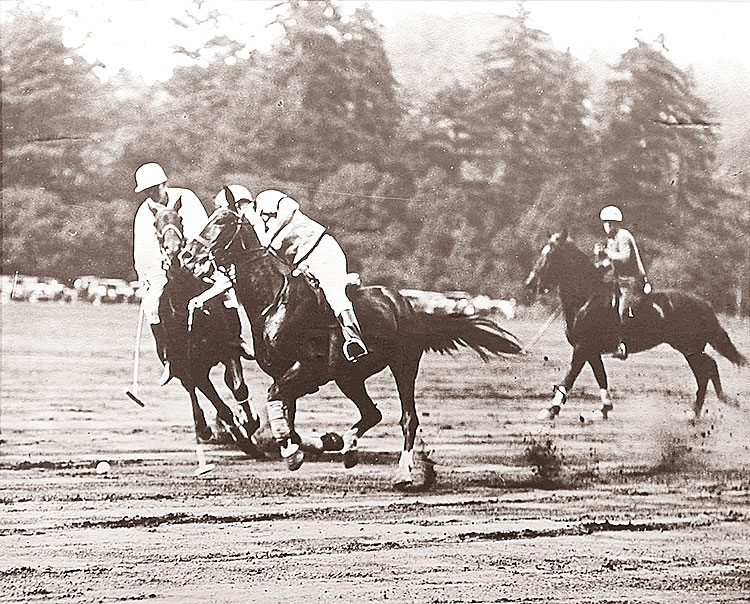By John Hibble

Muralist Art Thomae will be recreating the polo grounds as they once were, the center of society of a time long past. Donations for the new mural can be made by contacting Mary Russell at: mer4000@aol.com or call 831-661-5214.
How did the Polo Grounds Regional Park get its name? The park has a total area of sixty-two acres with forty hidden acres of flat alluvial plain located between Valencia Creek on the west and oak woodland hillsides on the north and east sides, topped by Huntington Drive. The valley empties out to the intersection of Soquel Drive, Rio Del Mar Boulevard, and Polo Drive.
The first time that this area gets any historical notice is when Claus Spreckels, the sugar millionaire, acquired it as part of his initial purchase of 2,390 acres from Rafael Castro in 1872 for use as a Thoroughbred horse ranch and as a summer get-away from his mansion in San Francisco.
Spreckels’ horses were legendary. An 1879 drawing of the Spreckels Ranch shows the racetrack in the center background with two sulkies. Two of Spreckels’ horses, Speculation and St. Cloud, are shown in the foreground and are named at the bottom of the scene. Speculation was purchased by Spreckels for $8,500, a princely sum 140 years ago.
The Spreckels mansion that you see in the drawing was built in 1877. The address today is 9565 Soquel Drive. The barns, stables and corrals were located about where Rio Del Mar Boulevard intersects Soquel Drive today.
Polo is a very ancient game originating in the Middle East. It was first played in the United States in 1876 and quickly became very popular. Not surprisingly, polo is also referred to as “The Sport of Kings” due to the expense of maintaining a string of ponies for the sport. Because of the numerous horses available on cattle ranches in the western United States Polo spread quickly. Even the Paniolo cowboys in Hawaii played regularly.
Polo started locally in Santa Cruz in 1922 when Polo enthusiasts first got together at Wilder Ranch for informal matches. In July of 1923, a more formal field opened at the corner of California and Bay Avenues in Santa Cruz, but what the Santa Cruz Polo Club really wanted was a facility with stables and accommodations for the players. In February 1924 they signed an agreement with the Aptos Ranch Company for the use of Spreckels’ former racing grounds, including the barns and stables, and thus, the polo era in Aptos began. At the same time, it was also announced that R. M. Elsom and Jack Taylor would operate a riding school/equestrian center at the same location.
The customary way to watch a polo match was to park your car along the edge of the field and to bring a picnic basket to share as you sat in your car and watched the match. Between 225 and 250 cars were parked around the field at that initial match and the Rotary boy’s band provided music.
In April of 1925, Leo Monroe, William Lyon, Larry Miller, and Joseph Greenberg, (later combined as Peninsula Properties) agreed to purchase all of the property from the Sommers in order to develop what would become Rio Del Mar. They actively marketed polo as part of their country club activities. They rented the polo field to the polo club for $1 per year and promised to upgrade the field if the club grew to 200 members. The Spreckels Mansion was the clubhouse for both the country club and the polo club. I think that Peninsula Properties was hoping that the polo club would either buy the property or lease it at an attractive rate once they had enough members. That never quite happened.
Four years later Peninsula Properties spruced up the Polo Grounds in time for the Grand Opening of their new $100,000 Hotel Don Rafael de Castro, May 1, 1929, on the bluff overlooking Monterey Bay. They planted turf on the formerly dusty Polo Grounds and had stables built to accommodate 40 ponies at the north end of the field. The former stables were torn down. By that time Redwood Village Motel had just been built next to where the old stables had been.
Even before the Stock Market crash, Peninsula Properties was probably facing cash flow problems. Within a very short time plans were made to generate income from the Polo Grounds property. By October of 1929 the company decided to lease the polo field for growing strawberries. Plans for roads and a subdivision there were submitted to the county in November. In addition to North and South Polo Avenues, three of the roads were named Monroe, Lyon and Miller. Miller Avenue later disappeared when the Highway One interchange was built.
In December of 1929, the temporary real estate offices near the beach were moved to the Polo Grounds for use as housing for the strawberry farm employees. By June 1930, cottages were being built. Eventually, in November of 1933 the Polo field was sold off as farmland.
The site continued to be farmed until 1977 when the County Agricultural Commissioner refused to continue to permit pesticide spraying so the property was left fallow for twelve years.
Several residential developments were proposed for the property including 400 housing units and a 99-bed nursing home but the county decided that a regional park was a more appropriate use and purchased the property in 1987.
The park was built by an army of volunteers and almost exclusively with funds raised by the community. The Grand Opening of Polo Ground County Park was held twenty years ago on September 1, 1997 but the 90 year-old memories of polo ponies and the sound of hooves and the cheering of the spectators will be preserved on the new mural.